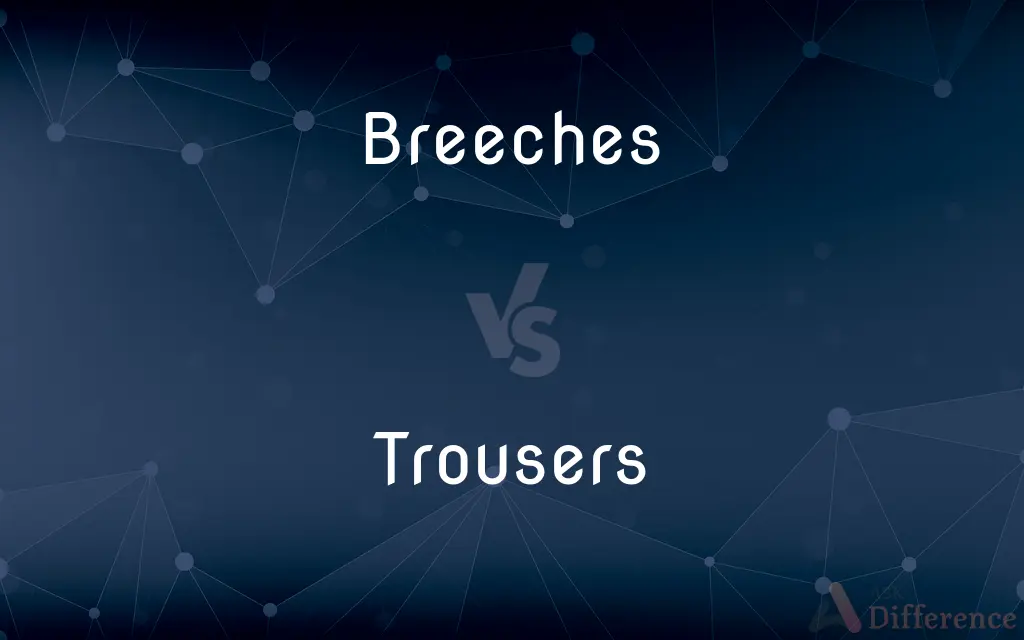Breeches vs. Trousers — What's the Difference?
By Tayyaba Rehman & Fiza Rafique — Updated on February 28, 2024
Breeches are knee-length garments worn for riding, fitting snugly from the waist to below the knee. Trousers are full-length garments covering the body from the waist to the ankles, worn by both genders in various contexts.

Difference Between Breeches and Trousers
Table of Contents
ADVERTISEMENT
Key Differences
Breeches, historically significant and often associated with horseback riding, are designed to fit tightly from the waist to just below the knee, where they usually fasten. This design is practical for riding, minimizing fabric interference while providing flexibility and protection. They often feature reinforced fabric or padding in areas that come into contact with the saddle. In contrast, trousers are a more universally worn garment, covering the entire leg from waist to ankles. They come in a wide variety of styles, materials, and fits, catering to different fashion trends, occupational needs, and personal preferences.
The distinction between breeches and trousers extends beyond length and fit. Breeches are typically made from durable, elastic materials to accommodate the physical demands of riding and may include details like buckles or straps at the lower part of the leg for a secure fit. Trousers, on the other hand, are made from a broad range of materials, from lightweight fabrics for casual wear to heavier, more durable materials for workwear. Their design prioritizes comfort, functionality, and style, adapting to the requirements of various activities and professional environments.
Breeches have a rich history and are often associated with traditional riding attire, reflecting a certain level of formality and heritage in equestrian circles. They are usually worn with tall riding boots that reach up to the knee. Trousers, however, are a staple in everyday and professional attire worldwide, evolving over time to reflect changes in fashion, societal norms, and technology. They can be paired with a wide range of footwear, from casual sneakers to formal dress shoes.
Breeches carry connotations of aristocracy and tradition, especially in historical and equestrian contexts. Trousers, by their universal nature, do not carry the same specific cultural connotations but play a significant role in cultural and fashion trends, workplace norms, and individual expression. Their adaptability and variety have made trousers an indispensable part of the modern wardrobe for people of all genders.
Understanding the differences between breeches and trousers is crucial for historical studies, fashion design, and professional attire, reflecting the evolution of clothing as a response to practical needs, cultural practices, and personal expression. While breeches serve a specific purpose within certain activities and traditions, trousers offer a universal solution to legwear with endless variations in style, material, and use.
ADVERTISEMENT
Comparison Chart
Length
Knee-length
Full-length, waist to ankles
Fit
Snug from waist to below the knee
Varies from loose to slim-fit
Purpose
Specifically designed for riding
General wear, various activities
Material
Durable, elastic materials
Wide range, from lightweight to heavy-duty
Historical Significance
Associated with aristocracy and equestrian traditions
Evolved as a practical garment, reflecting fashion and societal changes
Footwear Compatibility
Typically worn with tall riding boots
Compatible with a wide range of footwear
Cultural Connotations
Tradition and formality in riding circles
Universal wear, reflecting broader cultural and fashion trends
Compare with Definitions
Breeches
Worn with tall riding boots.
Her breeches tucked neatly into her polished riding boots.
Trousers
Full-length garments covering from waist to ankles.
He chose a pair of formal trousers for the meeting.
Breeches
Designed to minimize fabric interference while riding.
Breeches ensure comfort and flexibility during long rides.
Trousers
Made from a wide range of materials.
The lightweight linen trousers were perfect for the summer heat.
Breeches
Often made with reinforced areas for durability.
The breeches featured padded knees for extra protection.
Trousers
A staple in everyday and professional attire.
Trousers are an essential component of the office dress code.
Breeches
Carry connotations of aristocracy and tradition.
Breeches are a symbol of traditional equestrian attire.
Trousers
Reflect changes in fashion and societal norms.
The wide-legged trousers echoed a resurgence of vintage fashion trends.
Breeches
Breeches ( BRITCH-iz, BREE-chiz) are an article of clothing covering the body from the waist down, with separate coverings for each leg, usually stopping just below the knee, though in some cases reaching to the ankles. The breeches were normally closed and fastened about the leg, along its open seams at varied lengths, and to the knee, by either buttons or by a drawstring, or by one or more straps and buckle or brooches.
Trousers
Come in various styles and fits for different needs.
The work trousers were equipped with multiple utility pockets.
Breeches
Short trousers fastened just below the knee, now chiefly worn for riding or as part of ceremonial dress
A pair of buckskin breeches
Trousers
A garment worn by men and boys, extending from the waist to the knee or to the ankle, and covering each leg separately.
Breeches
Trousers ending above the knee
Trousers
Trousers (British English), slacks, or pants are an item of clothing that might have originated in Central Asia, worn from the waist to the ankles, covering both legs separately (rather than with cloth extending across both legs as in robes, skirts, and dresses). In the United Kingdom, the word pants generally means underwear and not trousers.
Breeches
Knee-length garments for riding, fitting snugly.
The rider donned his breeches before mounting his horse.
Trousers
An article of clothing that covers the part of the body between the waist and the ankles or knees, and is divided into a separate part for each leg.
The trousers need to be shortened.
Why can women wear trousers when men can’t wear skirts?
Trousers
(usually in the plural) a garment extending from the waist to the knee or ankle, covering each leg separately;
He had a sharp crease in his trousers
Common Curiosities
How do I choose between breeches and trousers?
The choice depends on the activity; breeches are for riding, while trousers are versatile for everyday wear and professional settings.
Are breeches still worn today?
Yes, breeches are still worn today, mainly within equestrian sports and activities.
Do breeches and trousers fit the same way?
No, breeches fit snugly from the waist to below the knee, while trousers' fit varies widely from slim to loose.
How have trousers evolved over time?
Trousers have evolved in response to changes in fashion, societal norms, and the introduction of new materials and technologies.
Are breeches considered formal wear?
In equestrian contexts, breeches can be part of formal attire, but their formality is specific to riding events.
Can trousers be worn for riding?
While trousers can be worn for casual riding, breeches are preferred for serious equestrian activities due to their specific design.
What makes trousers a staple in modern wardrobe?
Their versatility, variety of styles, and adaptability to fashion trends make trousers a staple.
What are breeches used for?
Breeches are primarily used for horseback riding, providing comfort and flexibility.
Can women wear breeches?
Absolutely, breeches are worn by both men and women in equestrian activities.
What is the significance of material in choosing breeches or trousers?
The material affects the garment's durability, comfort, and suitability for specific activities or weather conditions.
Share Your Discovery

Previous Comparison
Wince vs. Cringe
Next Comparison
Technomancy vs. TechnopathyAuthor Spotlight
Written by
Tayyaba RehmanTayyaba Rehman is a distinguished writer, currently serving as a primary contributor to askdifference.com. As a researcher in semantics and etymology, Tayyaba's passion for the complexity of languages and their distinctions has found a perfect home on the platform. Tayyaba delves into the intricacies of language, distinguishing between commonly confused words and phrases, thereby providing clarity for readers worldwide.
Co-written by
Fiza RafiqueFiza Rafique is a skilled content writer at AskDifference.com, where she meticulously refines and enhances written pieces. Drawing from her vast editorial expertise, Fiza ensures clarity, accuracy, and precision in every article. Passionate about language, she continually seeks to elevate the quality of content for readers worldwide.














































